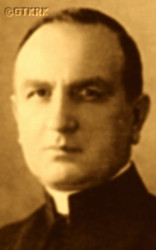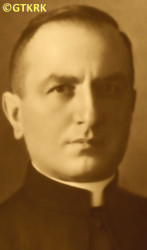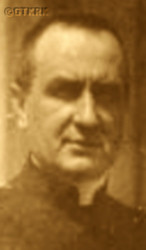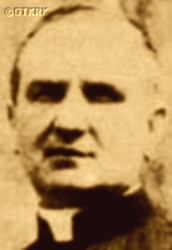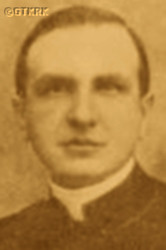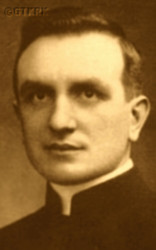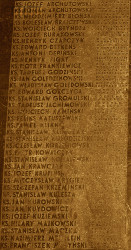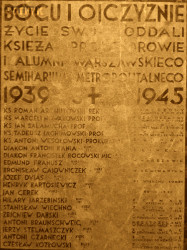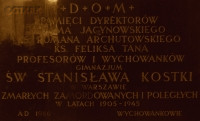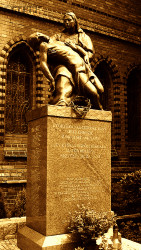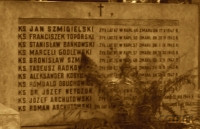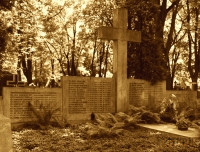Roman Catholic
St Sigismund parish
05-507 Słomczyn
85 Wiślana Str.
Konstancin deanery
Warsaw archdiocese, Poland
full list:
displayClick to display full list

searchClick to search full list by categories
wyświetlKliknij by wyświetlić pełną listę po polsku

szukajKliknij by przeszukać listę wg kategorii po polsku

Martyrology of the clergy — Poland
XX century (1914 – 1989)
personal data
religious status
blessed
surname
ARCHUTOWSKI
forename(s)
Roman
beatification date
13.06.1999more on
www.swzygmunt.knc.pl
[access: 2013.05.19]

the RC Pope John Paul IImore on
en.wikipedia.org
[access: 2014.09.21]
function
diocesan priest
creed
Latin (Roman Catholic) Church RCmore on
en.wikipedia.org
[access: 2014.09.21]
diocese / province
Warsaw archdiocesemore on
en.wikipedia.org
[access: 2013.05.19]
academic distinctions
Sacred Theology MA
honorary titles
Rochettum et Mantolettum canonmore on
Rochettum et Mantolettum canon
(c. 1929)
„Pro Ecclesia et Pontifice”more on
„Pro Ecclesia et Pontifice”
(c. 1922)
date and place
of death
18.04.1943

KL Lublinconcentration camp
today: Majdanek‐Lublin, Lublin city pov., Lublin voiv., Poland
more on
en.wikipedia.org
[access: 2022.01.09]
alt. dates and places
of death
19.04.1943
details of death
After German invasion of Poland in 09.1939 and start of the World War II organized — as a rector of Warsaw Catholic Theological Seminary — help to the persecuted Jews.
Arrested for the first time in 09.1942 for, among others, this help to the Jews.
Jailed in Pawiak prison in Warsaw.
Tortured.
Released after a month.
Arrested again on 10.11.1943.
Incarcerated again in Pawiak jail.
From there on 25.03.1943 transported to KL Lublin (Majdanek) concentration camp where perished — contracting typhoid.
cause of death
extermination
perpetrators
Germans
sites and events
KL Lublin (Majdanek)Click to display the description, PawiakClick to display the description, Help to the JewsClick to display the description, GeneralgouvernementClick to display the description, Ribbentrop‐MolotovClick to display the description, Pius XI's encyclicalsClick to display the description
date and place
of birth
05.08.1882

Karolinotoday: Serock gm., Legionowo pov., Masovia voiv., Poland
more on
en.wikipedia.org
[access: 2022.01.28]
parents
ARCHUTOWSKI Theophilus Felix
🞲 1842, Zalesie Borowetoday: Serock gm., Legionowo pov., Masovia voiv., Poland
more on
en.wikipedia.org
[access: 2025.02.23] — 🕆 16.08.1915, Gzowotoday: Pokrzywnica gm., Pułtusk pov., Masovia voiv., Poland
more on
en.wikipedia.org
[access: 2025.02.22]

KARWOWSKA Emily
🞲 1853, Karolinotoday: Serock gm., Legionowo pov., Masovia voiv., Poland
more on
en.wikipedia.org
[access: 2022.01.28] — 🕆 27.09.1918, Gzowotoday: Pokrzywnica gm., Pułtusk pov., Masovia voiv., Poland
more on
en.wikipedia.org
[access: 2025.02.22]
baptism
08.08.1882

Zegrzetoday: Serock gm., Legionowo pov., Masovia voiv., Poland
more on
pl.wikipedia.org
[access: 2021.12.19]
St Anthony of Padua, St Barbara and St Rock RC church
presbyter (holy orders)
ordination
1904

Warsawtoday: Warsaw city pov., Masovia voiv., Poland
more on
en.wikipedia.org
[access: 2021.10.09]
St John the Baptist Martyrdom RC archcathedral churchmore on
pl.wikipedia.org
[access: 2014.11.14]
positions held
1940 – 1942
rector — Warsawtoday: Warsaw city pov., Masovia voiv., Poland
more on
en.wikipedia.org
[access: 2021.10.09] ⋄ Metropolitan Theological Seminary
1925 – 1940
director — Warsawtoday: Warsaw city pov., Masovia voiv., Poland
more on
en.wikipedia.org
[access: 2021.10.09] ⋄ St Stanislav Kostka's gymnasium — also: censor of religious books (Lat. censores librorum)
c. 1925
vicar — Warsawtoday: Warsaw city pov., Masovia voiv., Poland
more on
en.wikipedia.org
[access: 2021.10.09] ⋄ Holy Cross RC parish ⋄ Warsaw‐in‐urbedeanery name
today: Warsaw city pov., Masovia voiv., Poland RC deanery
c. 1923 – c. 1939
promoter of justice — Warsawtoday: Warsaw city pov., Masovia voiv., Poland
more on
en.wikipedia.org
[access: 2021.10.09] ⋄ 2nd instance, Archbishop's Metropolitan Court
1910 – 1925
prefect — Warsawtoday: Warsaw city pov., Masovia voiv., Poland
more on
en.wikipedia.org
[access: 2021.10.09] ⋄ secondary schools — i.a. in St Stanislav Kostka's Gymnasium and the Warsaw Real School (1910‐1915)
1905 – 1910
student — Sankt Petersburgtoday: Saint Petersburg city, Russia
more on
en.wikipedia.org
[access: 2020.07.31] ⋄ philosophy and theology, Imperial Roman Catholic Spiritual Academy (1842‐1918) — postgraduate specialised studies crowned with a Sacred Theology Master's degree
1904 – 1905
vicar — Jeżówtoday: Jeżów gm., Brzeziny pov., Łódź voiv., Poland
more on
en.wikipedia.org
[access: 2020.11.27] ⋄ St Andrew the Apostle RC parish ⋄ Brzezinytoday: Brzeziny urban gm., Brzeziny pov., Łódź voiv., Poland
more on
en.wikipedia.org
[access: 2020.11.27] RC deanery
till 1904
student — Warsawtoday: Warsaw city pov., Masovia voiv., Poland
more on
en.wikipedia.org
[access: 2021.10.09] ⋄ philosophy and theology, Metropolitan Theological Seminary
others related
in death
CHŁOPECKIClick to display biography Romualdo, KAŚCIŃSKIClick to display biography Leopold, KOWCZClick to display biography Emilian, KOZŁOWSKIClick to display biography Valery, LESZCZYKClick to display biography Anthony, MODRZEWSKAClick to display biography Hedwig Joanna Gabrielle, NIEROSTEKClick to display biography Joseph, OSIKOWICZClick to display biography Andrew, PECIAKClick to display biography Louis, TROCHAClick to display biography Peter (Bro. Adalbert Marian)
sites and events
descriptions
KL Lublin (Majdanek): Operational in 1941‐1944, in Majdanek village n. Lublin, German Germ. Konzentrationslager (Eng. concentration camp) KL and „death” camp. Prisoners were not only local, from Lublin region, but from all over pre‐war Poland and from abroad. Most of them were Jewish, but also member of Polish clandestine resistance (part of Polish Clandestine State), Polish intelligentsia, Russian POWs, inhabitants of Zamość area evicted by the Germans, people captured in round‐ups in Polish towns and cities. 6% of the prisoners were children 14 years old and younger. Prisoners slaved at c. 16 sub‐camps working for German companies, such as Deutsche Ausrüstungswerke (DAW). Altogether c. 150,000 people were held in the camp. C. 79,000 victims were murdered, among them c. 59,000 Jews. The camp was equipped with 5 gas chambers, where prisoners were mass murdered, using gas from bottles or from capsules of Zyklon B. (more on: www.majdanek.euClick to attempt to display webpage
[access: 2012.11.23], en.wikipedia.orgClick to attempt to display webpage
[access: 2013.08.10])
Pawiak: Investigative prison in Warsaw, built by the Russian occupiers of Poland in 1830‐1835. During the Poland partition's period, a Russian investigative prison, both criminal and political. During World War II and the German occupation, the largest German prison in the Germ. Generalgouvernement (Eng. General Governorate). Initially, it was subordinate to the Justice Department of the General Governorate, and from 03.1940 Germ. Sicherheitspolizei und des Sicherheitsdienst (Eng. Security Police and Security Service) of the Warsaw District — in particular the German Secret Political Police Gestapo. c. 3,000 prisoners were kept in Pawiak permanently, of which about 2,200 in the men's unit and c. 800 in the women's unit (the so‐called Serbia) — with a „capacity” of c. 1,000 prisoners. In total, in the years 1939‐1944, c. 100,000 Poles passed through the prison, of which c. 37,000 were murdered in executions — from 10.1943 Pawiak prisoners were murdered in open executions on the streets of Warsaw (sometimes several times a day) — during interrogations, in cells or in a prison „hospital”, and c. 60,000 were taken in 95 transports to concentration camps (mainly KL Auischwitz), other places of isolation or to forced labor. The prison Germans demolished during the Warsaw Uprising in 08‐10.1944. (more on: en.wikipedia.orgClick to attempt to display webpage
[access: 2022.08.17])
Help to the Jews: During World War II on the Polish occupied territories Germans forbid to give any support to the Jews under penalty of death. Hundreds of Polish priests and religious helped the Jews despite this official sanction. Many of them were caught and murdered.
Generalgouvernement: After the Polish defeat in the 09.1939 campaign, which was the result of the Ribbentrop‐Molotov Pact and constituted the first stage of World War II, and the beginning of German occupation in part of Poland (in the other, eastern part of Poland, the Russian occupation began), the Germans divided the occupied Polish territory into five main regions. In two of them new German provinces were created, two other were incorporated into other provinces. However, the fifth part was treated separately, and in a political sense it was supposed to recreate the German idea from 1915 (during World War I, after the defeat of the Russians in the Battle of Gorlice in 05.1915) of creating a Polish enclave within Germany. Illegal in the sense of international law, i.e. Hague Convention, and public law, managed by the Germans according to separate laws — especially established for the Polish Germ. Untermenschen (Eng. subhumans) — till the Russian offensive in 1945 it constituted part of the Germ. Großdeutschland (Eng. Greater Germany). Till 31.07.1940 formally called Germ. Generalgouvernement für die besetzten polnischen Gebiete (Eng. General Government for the occupied Polish lands) — later simply Germ. Generalgouvernement (Eng. General Governorate), as in the years 1915‐1918. From 07.1941, i.e. after the German attack on 22.06.1941 against the erstwhile ally, the Russians, it also included the Galicia district, i.e. the Polish pre‐war south‐eastern voivodeships. A special criminal law was enacted and applied to Poles and Jews, allowing for the arbitrary administration of the death penalty regardless of the age of the „perpetrator”, and sanctioning the use of collective responsibility. After the end of the military conflict of the World War UU, the government of the Germ. Generalgouvernement was recognized as a criminal organization, and its leader, governor Hans Frank, guilty of war crimes and crimes against humanity and executed. (more on: en.wikipedia.orgClick to attempt to display webpage
[access: 2024.12.13])
Ribbentrop‐Molotov: Genocidal Russian‐German alliance pact between Russian leader Joseph Stalin and German leader Adolf Hitler signed on 23.08.1939 in Moscow by respective foreign ministers, Mr. Vyacheslav Molotov for Russia and Joachim von Ribbentrop for Germany. The pact sanctioned and was the direct cause of joint Russian and German invasion of Poland and the outbreak of the World War II in 09.1939. In a political sense, the pact was an attempt to restore the status quo ante before 1914, with one exception, namely the „commercial” exchange of the so‐called „Kingdom of Poland”, which in 1914 was part of the Russian Empire, fore Eastern Galicia (today's western Ukraine), in 1914 belonging to the Austro‐Hungarian Empire. Galicia, including Lviv, was to be taken over by the Russians, the „Kingdom of Poland” — under the name of the General Governorate — Germany. The resultant „war was one of the greatest calamities and dramas of humanity in history, for two atheistic and anti‐Christian ideologies — national and international socialism — rejected God and His fifth Decalogue commandment: Thou shall not kill!” (Abp Stanislav Gądecki, 01.09.2019). The decisions taken — backed up by the betrayal of the formal allies of Poland, France and Germany, which on 12.09.1939, at a joint conference in Abbeville, decided not to provide aid to attacked Poland and not to take military action against Germany (a clear breach of treaty obligations with Poland) — were on 28.09.1939 slightly altered and made more precise when a treaty on „German‐Russian boundaries and friendship” was agreed by the same murderous signatories. One of its findings was establishment of spheres of influence in Central and Eastern Europe and in consequence IV partition of Poland. In one of its secret annexes agreed, that: „the Signatories will not tolerate on its respective territories any Polish propaganda that affects the territory of the other Side. On their respective territories they will suppress all such propaganda and inform each other of the measures taken to accomplish it”. The agreements resulted in a series of meeting between two genocidal organization representing both sides — German Gestapo and Russian NKVD when coordination of efforts to exterminate Polish intelligentsia and Polish leading classes (in Germany called «Intelligenzaktion», in Russia took the form of Katyń massacres) where discussed. Resulted in deaths of hundreds of thousands of Polish intelligentsia, including thousands of priests presented here, and tens of millions of ordinary people,. The results of this Russian‐German pact lasted till 1989 and are still in evidence even today. (more on: en.wikipedia.orgClick to attempt to display webpage
[access: 2015.09.30])
Pius XI's encyclicals: Facing the creation of two totalitarian systems in Europe, which seemed to compete with each other, though there were more similarities than contradictions between them, Pope Pius XI issued in 03.1937 (within 5 days) two encyclicals. In the „Mit brennender Sorge” (Eng. „With Burning Concern”) published on 14.03.1938, condemned the national socialism prevailing in Germany. The Pope wrote: „Whoever, following the old Germanic‐pre‐Christian beliefs, puts various impersonal fate in the place of a personal God, denies the wisdom of God and Providence […], whoever exalts earthly values: race or nation, or state, or state system, representatives of state power or other fundamental values of human society, […] and makes them the highest standard of all values, including religious ones, and idolizes them, this one […] is far from true faith in God and from a worldview corresponding to such faith”. On 19.03.1937, published „Divini Redemptoris” (Eng. „Divine Redeemer”), in which criticized Russian communism, dialectical materialism and the class struggle theory. The Pope wrote: „Communism deprives man of freedom, and therefore the spiritual basis of all life norms. It deprives the human person of all his dignity and any moral support with which he could resist the onslaught of blind passions […] This is the new gospel that Bolshevik and godless communism preaches as a message of salvation and redemption of humanity”… Pius XI demanded that the established human law be subjected to the natural law of God , recommended the implementation of the ideal of a Christian state and society, and called on Catholics to resist. Two years later, National Socialist Germany and Communist Russia came together and started World War II. (more on: www.vatican.vaClick to attempt to display webpage
[access: 2023.05.28], www.vatican.vaClick to attempt to display webpage
[access: 2023.05.28])
sources
original images:
www.kielakowie.plClick to attempt to display webpage
[access: 2016.11.06], www.nsz.com.plClick to attempt to display webpage
[access: 2025.08.19], www.idziemy.plClick to attempt to display webpage
[access: 2019.10.13], pl.wikipedia.orgClick to attempt to display webpage
[access: 2016.11.06], grekat.blogspot.comClick to attempt to display webpage
[access: 2016.11.06], www.antoni.agmk.netClick to attempt to display webpage
[access: 2013.06.11], www.szczecin.plClick to attempt to display webpage
[access: 2014.09.21], commons.wikimedia.orgClick to attempt to display webpage
[access: 2016.04.23], cmentarze.um.warszawa.plClick to attempt to display webpage
[access: 2016.04.23]
LETTER to CUSTODIAN/ADMINISTRATOR
If you have an Email client on your communicator/computer — such as Mozilla Thunderbird, Windows Mail or Microsoft Outlook, described at WikipediaPatrz:
en.wikipedia.org, among others — try the link below, please:
LETTER to CUSTODIAN/ADMINISTRATORClick and try to call your own Email client
If however you do not run such a client or the above link is not active please send an email to the Custodian/Administrator using your account — in your customary email/correspondence engine — at the following address:

giving the following as the subject:
MARTYROLOGY: ARCHUTOWSKI Roman
To return to the biography press below:
 Click to return to biography
Click to return to biography








